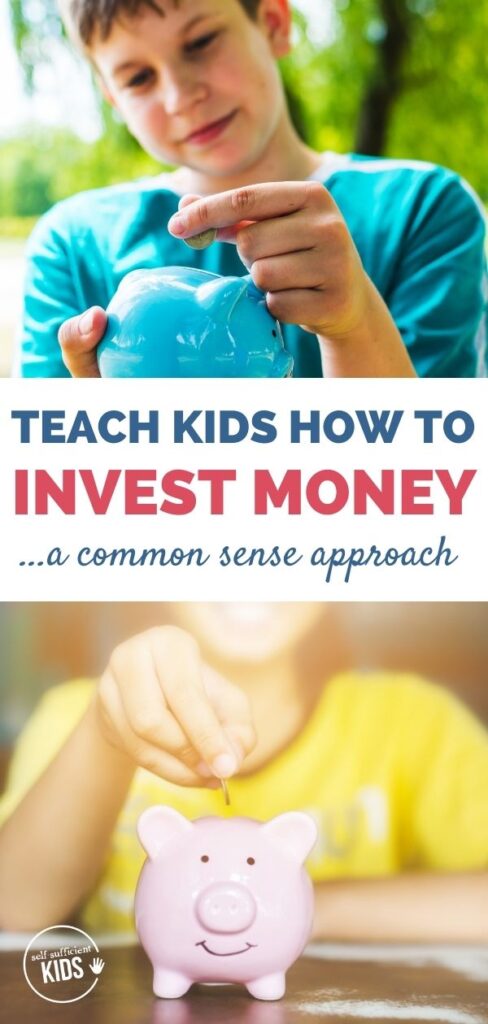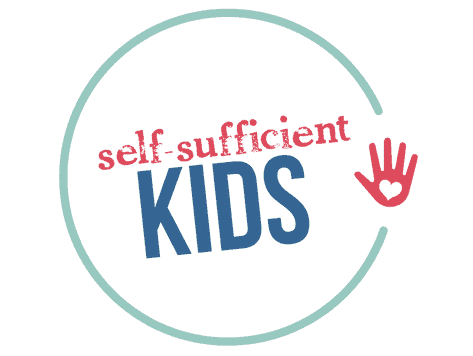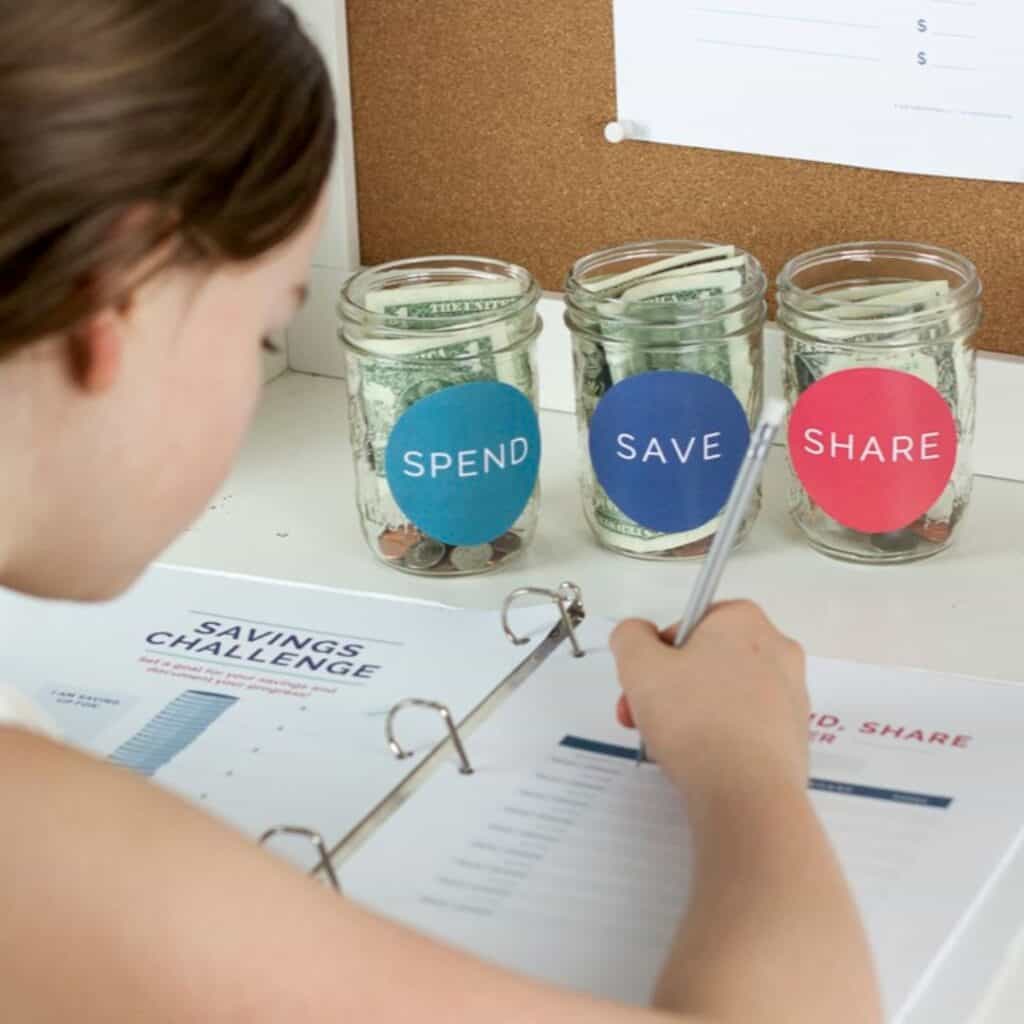Investing for Kids: a Common Sense Approach to Teaching the Basics
Investing for kids doesn’t need to be complicated. This approach will equip your children with the basics so they can make wise investing decisions.

“Why would I ever want to put my money in this retirement plan?” I boldly, and possibly a bit too pointedly, asked a senior-level manager.
Looking over what he had just presented to us as a new company “benefit”, I wasn’t impressed.
And the manager didn’t have an answer for me. Because the truth was there was no reason why anyone should put their earnings in that plan. The fees were too high, the investment portfolio wasn’t well diversified, and the company wasn’t even matching employee contributions.
I knew I’d be better off putting my savings in a Roth IRA invested in low-cost index funds I managed on my own. I had learned over the years, through my father, a college investments class, and my own personal reading, what makes for a good retirement plan.
Looking back at the performance of that IRA (individual retirement account) over the years, I’m grateful I didn’t make the mistake of investing in my employer’s plan.
But what if I hadn’t known better? What if I had blindly invested in the company’s plan without realizing there were superior investment options?
The mistake could have cost me thousands of dollars — money that instead, helped build my retirement savings and create a more secure financial future.
Begin with investing basics
Investing isn’t just for the rich. Our children – both boys and girls – will almost certainly need to make investment decisions at some point in their adulthood, no matter what their financial status.
For example, today, 79% of all employers in the United States offer an employee retirement plan. This alone means the chances are high that our children will be presented with the opportunity to invest at some point in their future.
But many people don’t understand investing well enough to know they should be doing it, either through retirement plans or on their own. Those that do understand often aren’t equipped with enough knowledge to make wise investment decisions.
Fortunately, it doesn’t take much to arm our children with the basic knowledge needed to spark an interest in investing and make good, even if unsophisticated, fundamental decisions. Our kids don’t need to be masterful stock traders (nor is that even desirable). But educating them at a young age with a few key concepts and nurturing a saving mindset in them will set them up for success.
To keep things simple, our primary goals when teaching investing to kids should be to:
- Provide kids with firsthand experience in saving and investing
- Convey basic investment concepts
- Emphasize the immense benefit of getting started before age thirty
- Characterize investing as a long-term objective, not a short-term gamble

First, teach kids how to budget and save
Before they can grasp what it means to invest money, your kids will need to increase their financial literacy, primarily by understand budgeting and saving.
The best way to teach kids the importance of budgeting and saving is to let them manage some of their own money. This money, best given to them as an allowance, should be tied to certain expenses your child is responsible for.
For example, young children can be given the responsibility of buying non-essential items such as craft supplies, books, or toys.
Older teens can be given more responsibility such as paying for cell phone bills, gas for the car, clothing, and any entertainment expenses.
Providing kids with a bit of cash or a debit card, as well as making them responsible for certain expenses, provides a real-life learning experience of money management.
Kids should be given a small enough amount that they’ll need to save up for these items, but not so much that the goal is difficult to reach.
For more advice about setting up an allowance for your child see: How to Get Started on Kids Allowance – the Right Way
The Kids Money Management Toolkit has everything you need (except money!) to begin giving your kids an allowance. In addition to guidance and advice, you’ll also receive Save, Spend, and Share jar labels, a Kids Money Ledger, a Savings Challenge Sheet, a Jobs-for-Hire Sheet, and a Kids Allowance Contract. Click here to learn more.
Next, introduce kids to investing’s fundamental concepts:
The following are the investing concepts kids should understand. In each lesson, I’ve provided a very high-level explanation of the key concepts just to make it clear what I’m referring to. If you need to refresh your knowledge of these concepts, or even learn about them for the first time, I suggest using one of the many online resources available to educate adult investors (some are linked in the descriptions below).
What’s not in the list below are specific tips on how to teach these concepts to your children. I haven’t found, or yet developed myself, an effective, one-size-fits-all approach — despite there being plenty of videos and games out there aiming to accomplish exactly this. But if you know what you should be teaching your kids, it should make it easier to figure out how to teach it to them.
Bonds vs. stocks
Bonds and stocks are the most commonly traded assets among investors, so your child should understand what each means.
Stocks: Kids should know that buying a stock means you are purchasing a small piece of a company. In a very small way, people who own shares of a company’s stock are owners of that company. The price of a stock can fluctuate based on how well a company is doing financially or how well investors perceive it will do in the future. As the partial owner of the company, a stockholder may also receive some of the company’s profits in the form of dividends.
Bonds: Kids should also know that in comparison, buying a bond means essentially loaning money to either a company or a government. The expectation is that that entity will pay back the loan with interest. Bonds can be short-term or long-term and the length of the bond (or loan) influences the amount of interest paid. Bond holders are also able to sell their bonds to someone else at a higher or lower price than they originally purchased the bond. This exchange can cause bond prices to fluctuate.
Risk vs. reward
Understanding the relationship between risk and reward helps kids understand the idea of choosing between different types of investment.
Kids should know that regardless of the investment you choose, there will always be risk involved. The presence of risk means you could potentially lose a substantial amount or even all of the money you invested.
But kids should also know that there are degrees of risk. For example, a bond from the United States government typically isn’t very risky. It’s extremely likely the government will pay back the bond when it matures.
On the other hand, a share of stock from a small start-up company could be risky. Since the company has yet to establish itself, there’s a chance it will not do well financially in the future and the stock price may decrease.
Most importantly, kids should understand that the more risky the investment, the greater the chance of a high reward. Because it is less risky, a U.S. government bond’s price won’t vary much so it’s unlikely to have a big reward. On the other hand, there’s a chance (however small) that the small start-up could eventually become the next Google or Apple, making an early investor’s reward huge.
Diversification
This one can be hard for even adults to grasp, but it’s critical for kids to understand that due to risk, it’s important to own a variety of assets (such as stocks and bonds) at one time with different risk and return profiles. This is known as portfolio diversification.
Help kids see that, for example, if you were to invest all of your money in one company’s stock, a large portion of your savings could be lost if that stock plummeted.
But let’s say you held that company’s stock, as well as the stock of companies in different sectors, and also owned a few government bonds. Then, if something happened to one company, or one sector or even a government, only some of your money would be lost.
The main message for kids is that having a diversified portfolio of many different stocks and bonds is important. In order to have the greatest diversity, you’ll want to own stocks in companies in different sectors, that are different sizes and also reside in different countries. It’s also a good idea to own bonds that have different lengths of maturity (short or long-term).
An easy and low-cost way to achieve diversity is to purchase an index fund or shares of exchange traded funds (ETFs). (More on that later)
Compound interest
Hopefully for kids one of the most exciting aspects of learning about investing money is how a small amount can grow over many years.
Let’s say you buy a stock for $100 and that stock increases in value by 7% each year for ten years. At the end of the first year, you’d have $107. And at the end of ten years, you’d have $184. Not only does the amount you invested grow each year, but the interest gained from the previous year also grows. That’s why it’s called compound interest.
Because interest compounds over time, the longer you have your money invested the better. This chart illustrates how investing a small amount when you’re young can result in more money when you’re older even though the original investment was relatively small.
Ready to teach your child life skills? These cards can help! Each card in this eighty-one deck contains a skill your child can begin practicing with you or on their own. Click here or the image below to learn more.
Finally, give your kids hands-on experience by opening an investment account for them
With the previous steps finished, your kids have learned how to manage money through budgeting and saving and have been introduced to a few important investing concepts.
Now it’s time to put these abstract concepts into practice by opening an investment account for your child. Your child can add their allowance money, earned income or any cash gifts they’ve received to this account.
Having their own investment account sends a message to your child that you feel saving and investing money is important enough for you to make it real for them. It also provides them with hands-on experience with how investing works.
Don’t use the account to teach kids how to pick stocks
A lot of the advice out there about how to teach kids about the stock market says to have children purchase one or two stocks from favorite companies and see how they perform. Others advise having kids play a stock market fantasy game — usually focused on following individual stocks — to learn about stock trading.
But if our goal is to simply teach our children to make wise investment decisions, they don’t need to learn how to pick winning stocks. And furthermore, picking stocks isn’t something even professional brokers, let alone individual investors, have a consistent record of doing successfully.
Instead, we want a method that reinforces the concept of diversification and lets them see the power of compound interest over time.
Emphasize diversified investing with index funds or ETFs
Diversification is best achieved by investing in hundreds or even thousands of stocks. The best way to accomplish this, is to have your child invest their savings in either index funds or ETFs.
As a reminder, index funds are low-cost funds that are managed by a computer so they mimic the movement of a stock index like the S&P 500. These funds own a small number of shares in each company in the index they follow so index funds provide easy diversification. Plus, the fees of these funds are low, which means you get to keep more of your savings. The only problem for kids is that index funds typically require an initial investment of $2,000 to $3,000.
Since most children don’t have $3,000 in their savings accounts, an alternative is to invest in fractional shares of Exchange Traded Funds (ETFs). Many people aren’t even aware of ETFs. They’re essentially shares of mutual funds, including index funds, that get traded daily just like shares of stocks. Anyone can purchase a fractional share of an ETF for only a few dollars, making them perfect for new investors with very little in savings.
The details on the difference between index funds and ETFs is probably too much to get into with your child. But try to find a way to explain to them that they’re investing in the market overall, not individual stocks.
Don’t just have kids invest in stocks
Since the goal is to start our children off with a diversified portfolio, it should include a mix of stocks and bonds. ETFs provide this opportunity.
The process of deciding the right balance of stock and bonds may be too detailed to get into with your child right now. You may instead simply want to seek some guidance on the right portfolio allocation. It’s likely you’ll conclude that since your child has a long time horizon to invest they’re able to take on greater risk, such as holding 80% of their money in stocks and 20% in bonds. As stocks are inherently riskier than bonds, this allocation would provide them with some diversity while also maximizing their return.
To accomplish this, a child with $50 could invest:
$40 in Vanguard’s Total Stock Market ETF
$10 in Vanguard’s Total Bond Market ETF
The 80/20 allocation makes this a somewhat aggressive portfolio, but it should be perfect for a child who doesn’t need the money for many years.
If you’d like your child to take on less risk, either to teach them more conservative values or simply to minimize the chance of losing the money you’re investing, have him or her invest more of their money in the bond market ETF. If you’d like him or her to take on more risk, he or she could add to either of the stock ETFs.
Also, as your child ramps up in their understanding of the concepts involved in the decisions so far, other ETFs could be added to their portfolio to teach them about other asset classes, international assets, and provide even more diversification. But the idea at the beginning is to demonstrate what a simple, very well-diversified portfolio looks like.
Choosing an account for your child
Before your child begins investing, you’ll need to open an account for them. There are essentially two options parents have when opening an investment account for their children: custodial brokerage accounts and custodial Roth IRAs.
Minor children who don’t make money from work outside the home will need a custodial account. This account is owned by parents but transfers to the child once they’ve reached a certain age (18 or 21 depending on your state’s laws).
If your child is making any amount of money outside of the home, the best account for investing is a custodial IRA. IRAs come in two varieties, traditional and Roth. Most financial experts agree that Roth IRAs are the best option for youth since the money will grow tax-free for many decades. Not all banks or brokerage firms offer custodial IRAs, but Fidelity and Schwab do.
Additionally, keep in mind that not all banks offer fractional shares of ETFs. One company that makes it easy to invest in fractional shares – especially for kids – is Stockpile. This is a perfect solution if your child doesn’t qualify for an IRA. Stockpile also offers the Vanguard ETFs mentioned in the example portfolio above.
Above all, keep it simple and straightforward
Over the years I’ve come across many adults who are overwhelmed by the thought of investing their money. And so they either don’t invest at all, or if they do, they don’t make wise decisions. And it’s tragic — a missed opportunity for a better life for themselves and their loved ones.
Your kids don’t need to turn out this way. They can be taught to understand that investing doesn’t need to be complicated — especially when investing for the long-term using a highly diversified portfolio of stocks and bonds.
Demonstrating to our children that index funds or ETFs are typically safe, wise investments means they’ll be ready to make wise choices when a retirement plan is presented to them at work.
And hopefully, unlike me, they won’t be quite as candid with a senior manager if their company’s plan isn’t a great option.
See related:
Everything Your Child Needs to Know About Money Before Leaving Home
Teaching Kids to Delay Gratification in a “Buy Now, Pay Later” World
What to do next…
1. Subscribe to Self-Sufficient Kids’ email list.
Like what you read here and want to learn more? Every Thursday I’ll send you one parenting tip about raising self-sufficient kids and creating the peaceful relationship you yearn to have with your child. Click here to sign up.
2. Take one of my quizzes!
Find out if you’re raising a self-sufficient kid (click here) or if you’re doing too much for your kids (click here). At the end of each quiz, you’ll be asked to provide your email address to see the results.
3. Get your kids started on chores.
Learn how to get your child started on chores (& keep them motivated + avoid power struggles) by enrolling in my Get Your Kids Successfully Started on Chores course. Click here to learn more and sign up.

Kerry Flatley is the owner and author of Self-Sufficient Kids. She has a BA in economics, an MBA, a certificate in financial planning, and has been investing ever since she landed her first job. Kerry also has two girls, ages 13 and 15, who have been receiving allowance – and learning money management – for the past seven years.



